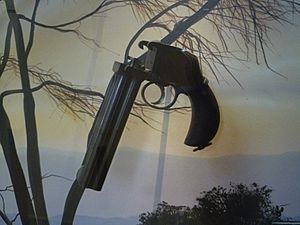Lancaster pistol facts for kids
Quick facts for kids Lancaster pistol |
|
|---|---|

Break action pepperbox at the Royal Armouries Museum in Leeds
|
|
| Type | Multi-barrel pistol |
| Place of origin | |
| Service history | |
| Wars | Anglo-Zulu War First Boer War Mahdist War Second Boer War World War I |
| Production history | |
| Designer | Charles W. Lancaster and Henry Thorn |
| Designed | c.1860 |
| Produced | mid to late 19th century |
| Specifications | |
| Cartridge | .38 S&W .450 Adams .455 Webley .577 Snider |
| Calibre | .380 inch .450 inch .455 inch .577 inch |
| Barrels | 2 or 4 |
| Action | Break-action, double action only, revolving striker |
| Feed system | one cartridge in each barrel |
The Lancaster pistol was a special type of handgun made in England. It was built in the mid to late 1800s. Unlike most pistols, it had more than one barrel, usually two or four. This pistol could fire different sizes of bullets.
The person who designed it was a gunsmith from London named Charles Lancaster. He started working with guns in 1847. In the 1850s, he came up with new ideas. These included a special way to make the inside of the gun barrel. He also invented a new type of bullet.
What Made the Lancaster Pistol Special?
The Lancaster pistol was a newer version of an older gun called a pepper-box pistol. Older pepper-box guns used a percussion cap to fire. But the Lancaster pistol used more modern brass cartridges. These were easier to load and more reliable.
One unique thing about the Lancaster pistol was its special barrel design. This design allowed it to fire even small .410 shotgun shells. It could also fire faster than other common pistols of its time. Sometimes, it had a special trigger to make it easier to shoot.
Why British Officers Liked It
The Lancaster pistol was popular with British officers. They used it in places like India and Africa. It was more reliable than other pistols. It could also fire more quickly. This made it a good choice for close-range defense. Hunters and explorers also liked it. They used it to protect themselves from large animals. These animals included tigers and cape buffalo.
Unlike some other pistols, the Lancaster pistol did not leak gas when fired. This made it more powerful. A very rare version was made for a ruler in India. It was a four barreled rifle used for hunting.
Fighting in Sudan
The bullets from the Lancaster pistol were very powerful. They were better than bullets from other pistols of the time. This made it good for fighting in wars in different parts of the world. For example, it was used against charging tribesmen. These included the Zulus and the Ansar in Sudan.
Modern bullets sometimes went straight through an enemy. But the heavy lead bullets from the Lancaster pistol would stop inside. This helped to bring down an enemy. A famous user was Lieutenant Colonel John Montague Benett Stanford. He was a photographer and war reporter. He used a Lancaster pistol to defend himself in a battle in Sudan.
Over time, newer Webley revolvers became popular. These revolvers were more reliable. They were also faster to reload. This meant the Lancaster pistol's advantages were not as important anymore. But some Lancaster pistols were still used as late as World War I. They were known for being strong and easy to take care of.

